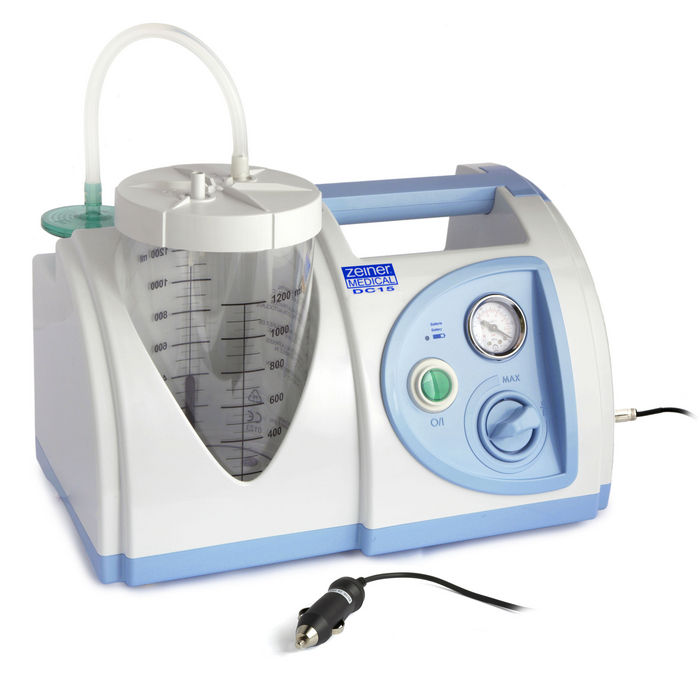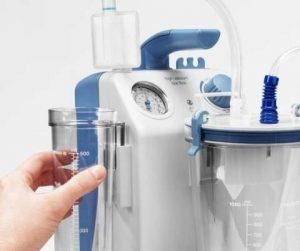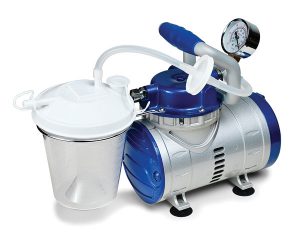Categories
The Best Medical Suction Pump Approved by Doctors

The human body is a mystery for all, but some of us dare to venture and explore its mechanics in order to figure out ways to treat and fix it. After all, we all get unwell. For the lucky ones medicines do the trick, but if these pills don’t work their magic the need to actually open up the body to remove the troubled area may be required. Yes, surgeries are fairly common in the world today and the advances in this field of medicine are staggering. A surgeon knows his anatomy to be able to navigate and treat different parts of the body. However, in order to reach the desired put a lot of barriers need to be cut.
Now, every part of us is kept alive by a constant supply of blood and cutting or breaking through them leads to a significant amount of bleeding. How then will a surgeon manage to find what he is looking for when all the organs are submerged in a pool of blood? This is where the medical suction pump comes in. This device is an ingenious invention that allows a surgeon to literally suck out all the excess fluid in the field of view to allow visibility and manipulation. Without it, operations would be more about finding the missing part than actual treatments. Hence, surgeons and medical personnel realize the importance of this essential piece of equipment.
Contents
What is a medical suction pump?
Basically, this is a vacuum device that is connected to a sterilized tube. The maximum pressure required is 60 KPa. This vacuum works at tolerable levels to suck out excess fluid or materials that may be obstructing the field of view or may need to be removed from the body. This can include blood, mucus, fluid, and even pieces of bone and pus. Hence, this device is a vital aid for any surgeon in the operation theater. A typical pump is made up of 4 components:
- Energy source, to provide the energy for the machine
- Machine to convert that energy into a vacuum
- filter, to filter out any large materials to prevent them from obstructing the apparatus
- Collection vessel, that will collect all the drained fluid and debris.
Types of medical suction pumps:
going to the very basics, the suction pump can be either portable or standard. Usually, the standard medical suction pump is connected to the mains electrical supply for energy. Portable suction pumps may be battery operated or they are manually made to create a negative pressure by hand or feet. In addition, they may also use compressed gas as a source of energy. The many suction pumps in the medical world are categorized according to their features and their use. However, based on the vacuum principle that they operate on, suction pumps may be divided into 3 categories, which include:
- electric motor pump, which is an electrically powered motor that drives a pump to create the required vacuum.
- Pneumatically driven pumps that primarily work on the Venturi principle. The driving force may be attributed to air, stream or water.
- A manually operated pump with bellows and unidirectional valves to create the necessary vacuum effectively.
Of course, with the advancement in time, these machines have been refined. The noise problem due to pistons has been reduced and their effectiveness increased. Nowadays, suction pumps come tailored to specific needs. Those for gynecology is different, whereas those for cardiac surgery are adapted to those anatomic sites better. Then dentistry and pus drainage. Long term drainage or drainage during surgery, all influence the type of surgical pump you will need. Plus, different surgical pumps are equipped with different technologies. For instance, those pumps required to drain pus have wider tubing and exert greater pressure than those needed in the eye. This is because high pressures in the eye may damage the delicate linings of this organ whereas have no effect on other places. Hence, the right choice of a specific surgical pump is critical for it to have the maximum effect.
Functions of medical suction pumps
There is numerous function of medical suction pumps, each greater than the last. Every surgical procedure and even some non-surgical ones use medical suction pumps. Without them, the treatment may not be possible and can even have dire consequences for the patient. The many functions include the following:
- Draining blood from operation sites allows the surgeon better visibility.
- To drain pus from an abscess
- To irrigate the side for washing and sucking out the excess water.
- To clean debris from a wound
- To suck out Mucus that may be obstructing the airways or other parts of the body.
- In gynecological processes to allow better vision and for draining the excess fluid.
- In dentistry to drain the blood and the irrigation fluid.
- To remove blood from the cranium after an extradural or intracranial hemorrhage.
- To suck out foreign bodies from the nose or ear or from other places.
- As constant intubation to provide drainage from a surgical site where pus or fluid may collect.
- To drain excessive edematous fluid from the peritoneal cavity in patients with ascites.
- To drain fluid from the lungs in patients with kidney disease or other major disorders.

In conclusion, almost every aspect of the medical field utilizes suction pumps. The portable pumps are handy for emergency usage. They can also be used for short procedures that won’t requires a lot of suction. Paramedic personnel also often use this kind of suction pumps to treat patients immediately.
Which is the best medical suction pump?
In the early years, there wasn’t much to the suction pump except a vacuum device and a vessel. Nowadays, doctors can regulate the pressures, there are different barrel systems for different purposes, tubings are adjusted for different use, and the whole apparatus is refined to suit a particular purpose. This has resulted in the creation of a number of different medical suction pumps. Also, with so many companies producing medical equipment out there, it becomes difficult to decide which one is the best. The ultimate decision lies on the doctor, of course, but here are some names that have created their name in the medical equipment industry. Their suction pumps are known to be some of the best. Here we will describe some of the company’s along with some of their suction pump models and specs.
Medalla
- Basic suction pump comes with a vacuum setting control and precise configuration settings. Intelligent technical features allow it to serve its purpose with excellence. It has a unique membrane vacuum regulator and reduced voice to allow for peaceful surgeries without constant noise. The high power vacuum is handy in a number of places and also aids cardiac tissue stabilizers.
- Dominant flex, a high vacuum pump suitable for liposuction, general surgery, other operations and with cardiac tissue stabilizers. It has Conclusion easily adjustable flow rates and easily cleanable parts, which make it an efficient machine.
- Vario 18 c/I provides intermittent suction as well as constant suction for delicate and precise drainage. It makes the suction pump ideal for gastric or general surgeries. It allows 30 minutes of a cordless operating system with no noise, making it a great portable, multi-purpose suction pump.
- A disposable collection system, with two liner sizes that provide an easy and hygienic solution to fluid collection. It comes in 1500cc and 2500cc sizes with added precautions like overflow protection, a bacterial filter and a non return valve to prevent regurgitation.

DeVilbiss
- heavy-duty suction pump, the device is capable of creating a 560 mm Hg vacuum. It also has an 800 ml collection bottle for easy use. Equipped with an excellent vacuum regulator, anti-vibration vacuum gauge, permanent lubrication and overflow protection, the device is clearly one of the best on the market.
VacuAide
- QSU Quiet Suction Unit has a 50% reduction in sound and has adjustable pressure from 50 to 560 mm Hg. It also supports a free fluid flow rate of 27 L/min. Can be used with a one hour back up lead battery adding portability to its list of benefits.
- Compact medical Unit, is a small yet powerful suction unit that you can carry in a bag discreetly. It is travel-friendly, with a 1-hour lead battery backup and a 27 l/ hour free fluid flow rate. This makes it great for draining pus at surgical sites after an operation and for draining free edematous fluid, on the go.
Comparative analysis
There are a number of notable names out there, including Medalla, Sunrise Medical, Penlon. However, the decision to choose one relies on a number of factors. Each company produces remarkable machines, but the ultimate decision relies on your own priorities. Things to consider when opting to buy a medical suction machine include
- Effectivity, which is, of course, the top post priority in patient care
- Infection control, to prevent any spread or growth of infection.
- Size, to ensure it is accomadated in your premises
- ease of use, how well the medical personnel can use it or will they require training
- Cost, the budget can be a severely limiting factor
- Appearance, whether it is aesthetically pleasing to your environment and the patients as well or is it just a mass of tubes.
- Warranties and servicing, whether the company has any maintenance and repair policy, what services is it offering.
- Portability, you may need to move the machine, hence it being portable is a critical factor.
- Testing, what proof is available of its effectiveness. Has it been tested out in similar situations before? What are its success stats?
All this matters a lot. However, you do have to come up with a single choice. Experts prefer the Penlon equipment. This is becuase its designs are simple and considerably easier to use. They are also light weight and have a thorough infection control mechanism built into themselves. These measures include in-built membrane system, which diminishes the number of filter changes, safety chamber to collect overflow secretions in case of emergencies, plus on top of it all it is portable, catering to the varied needs of the patients.
Conclusion
All in all, the medical suction pump is a vital piece of equipment at medical facilities. Hence, choosing the right equipment for the job is necessary. You need to look into the specifics of each machine to ensure that it really suits your needs. Plus, some equipment may require training also. How can you expect anyone to utilize a machine to its full capacity without knowing how to operate it. Taking all this into consideration is essential. It could mean the difference between the life and death of a patient!



